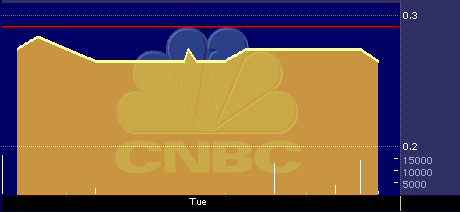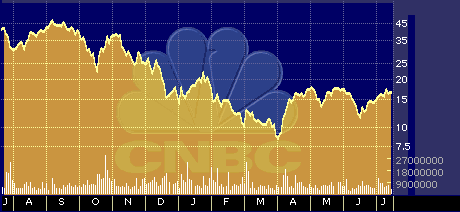
Hacker Attacks Overshadow Buy.com IPO
Hacker Attacks Overshadow Buy.com IPO
by Hal Plotkin and Scott Bomboy
Concerns over a new set of hacker attacks on prominent Web sites overshadowed a big day for Buy.Com Inc. {BUYX} and spread to a shutdown of popular auction site eBay {EBAY}, shopping site Amazon.com {AMZN} and news site CNN {TWX}.
Buy.com shares nearly doubled in the stock’s debut in early Tuesday today. But the online retailer’s Web site went offline later in day for three hours, taking some wind out of the company’s sails, as hackers tied up the company’s main computer servers.
Late Monday, the company priced its 14 million share offering at 13, up from its stated range of between 10 and 12. In early trading, Buy.Com shares topped 30 in active trading. However, by mid-afternoon, reports surfaced the company was having technical problems that prevented customers from accessing the site.
A spokeswoman later confirmed the site problems and said that Buy.com’s technical people were working to fix the problem. Later, The Wall Street Journal’s Steve Frank, appearing on CNBC’s Market Wrap, confirmed that Buy.Com’s problems were related to a “denial of service” action, similar to the attack on Yahoo! on Monday.
“The attack came from as far as we can tell at this point three locations across the country according to Buy.Com,” said Frank. “The locations were in Chicago, Boston and New York. … The site at its peak was hit by 800 megabits of information per second, slightly shy of what Yahoo! was hit with yesterday.”
Later on Tuesday, eBay, Amazon and CNN acknowledged similar outages, caused by a sudden jump in traffic to its Web servers.
Buy.com’s first-day trading success came despite concerns that some analysts expressed about the company’s long-term business prospects.

Buy.ComPost-IPO Stock-Performance Chart
Buy.Com, based in Aliso Viejo, Calif., is an online discount retailer of consumer products, such as computer hardware and peripherals, software, books, DVDs and music. The company lost $89.8 million on revenue of $398 million for the nine months ended Sept. 30.
The company’s strategy of undercutting other online retailers on price accounts for much of those losses. The company routinely sells items at, or slightly under, wholesale cost.
“They’ve done a very good job of using a price advantage as a way to build up their brand name,” says George Barto, senior analyst at the Gartner Group, based in Stamford, Conn. “That’s been a very good strategy.”
Analysts say Buy.Comis already well-known among Web-savvy consumers, many of whom like to invest in Internet companies with familiar names.
Buy.Com consistently ranks as one of the 40 most-popular Internet sites. More important, Buy.Com was the third-fastest-growing Web site during November, with monthly traffic increasing from 2.05 million unique visitors in October to more than 4.7 million unique visitors, a gain of 129 percent, according to Media Metrix, based in New York. Only Toysrus.com and Kbkids.com grew at a faster clip in November.
By contrast, the Net’s leading online retailer, Amazon.com Inc. {AMZN}, had 15.3 million unique visitors over the same period.

Amazon.com 52-Week Stock-Performance Chart
Buy.Com has been gaining ground without the same kind of expensive national advertising campaign that made its rival, Amazon.com, a household name. Instead, the company gets much of its online traffic from third-party online shopping intermediaries, such as brodia.com or shopping.com, which point consumers to the lowest online prices for individual items.
Buy.Com’s prices on many items are often the lowest available, though sometimes by just a few pennies, which is enough to win first place on many online price-comparison lists.
The company’s business strategy calls for thin to non-existent margins on many products, losses it hopes to make up from advertisers drawn to the site.
“Our surveys tell us that price has been an extremely critical factor for people shopping online,” Barto says. “It’s been an excellent way to get customers.”
Several analysts, however, caution that Buy.Com may have a much tougher time further down the road.
“I’m not a big fan of Buy.Com,” says Andrew Bartels, an analyst at the Giga Information Group, based in New York, adding that Buy.Com’s business strategy reminds him of a joke attributed to Bill Gates. Gates, lampooning current online trends, has reportedly said he’s planning on giving away dollar bills online for 90 cents and then making up the difference in advertising.
“It’s a very bizarre concept,” Bartels says about BUY.COM’s business model. “It’s hard to see how it works in the long run.”
Carrie Johnson, an associate analyst at Forrester Research, based in Cambridge, Mass., shares some of Bartels’ skepticism. “In a few years, price is not going to be the most important factor when it comes to online shopping,” she says.
Amazon.com, Johnson notes, doesn’t compete on price but instead emphasizes convenience and good customer service. “Two years from now, when all your favorite retailers are online you’ll just go there,” she says. “Brand-name retailers are going to have an advantage. If I want my makeup, I’ll go to the brand I know.”


